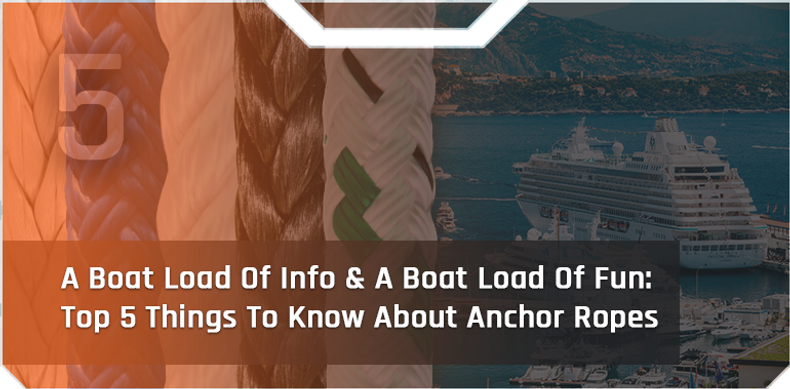Do you have your life vest on?
Your boat shoes?
It seems like it is time for us to have the talk. There comes a point in everyone’s life where they need to learn about anchor ropes for their pleasure boats.
For you, that time is now.
A lot of things have happened to get us to this moment. You bought your boat, you secured a place to drop your anchor, you bragged to all of your friends, and you joined a vicious gang of delinquent boaters. We are here to tell you a few tips - 5 of them exactly about choosing anchor ropes for your awesome boat.
1. Living In The Material World
Whether you are using a rope on its own or with a chain, most anchor ropes are made of nylon. You can find some anchor lines made with polyester or even some other synthetic materials, but nylon is really the standard for anchoring, and for some very good reasons.
Whether you are looking at fishnet stockings or a marine line, you will find that nylon is a pretty flippin’ awesome choice of fibers.
Some Advantages Of Nylon:
- Durability
- Lightweight
- High Stretch
- Water-Resistant
- Shock Absorbent
- Maintains Its Shape
- High Tensile Strength
- Doesn’t Float (We’ll Get To This A Little Later)
2. Stranded In The Water
The strand count of an anchor rope is another important thing to consider. This topic is a little more subjective than the issue of materials.
Both 3 strand ropes and solid braid ropes are pretty traditional setups for anchors, and both are decent choices.
The Coolest Thing About Solid Braid Ropes:
- The Most Flexible Option
The Coolest Things About Three Strand Braid Ropes:
- Inexpensive
- Best Option For Splicing
- Great For Use With Chains
- Perfect For Use With Old & Worn Out Windlass Hardware
With all of these things in mind, a double-braid anchor rope may just be the perfect happy medium between these two popular options.
The Case For Double Braid Anchor Ropes:
- Durable
- Resilient
- Highest Strength
- A Solid Choice For Splicing
- More Flexible Than 3 Strand Ropes
When it comes to strand counts, this truly is a matter of preference. Whether you are going to be attaching the rope to a chain or not is an important factor. Beyond that, whether you are more concerned about splicing or flexibility will likely be the defining factor for what kind of construction you choose.
3. You’ve Got Enough On Your Plait Already
Well, actually maybe you really want some plait in your life. The 8-Plait setup for anchor ropes is popular because it’s soft on the hands and just as strong as 3 strand ropes.
The #1 biggest drawback to an 8-plait is that with its softness, you will end up compromising on durability. If you don’t mind replacing your anchor lines fairly frequently, that may not be as big of an issue though. After all, you are doing well enough in your life to have a boat!
4. Going To Great Lengths To Find The Right Rope & Fun With Diameters
You probably want to know what size rope you should get, huh? Despite the fact that you are coming off as maybe a bit, too demanding, we are going to help you out.
Conventional boater wisdom says that you are going to want ⅛” in diameter for every 9-foot measurement of your boat. For example, an 18-foot long boat could call for a rope with a 2/8” (¼”) diameter. Anything between 18 feet and 27 feet of the boat would call for a ⅜” diameter.
This is not a perfect science and there are plenty of boaters that would simply say a ⅜” rope is most ideal for any rope under 40 ft long and that a 40-foot boat would call for a ½” rope.
A More Simple Rule:
- ⅜” Diameter Rope Should Cover Most Boats Under 40 FT Long
- ½” Diameter Rope Would Be Good For Most Boats Around 40 FT Long
As far as length goes, you will be thinking about how deep your anchor is going to be cast more than the length of your boat. You want about 8 feet of anchor rope for each foot of anchoring depth.
5. Float Your Boat, Sink Your Anchor
When it comes to your life, do whatever floats your boat without sinking others.
When it comes to your anchor line, you want to use a rope that doesn’t float. Floating ropes made out of materials like polypropylene should be avoided for your safety.
In the unfortunate scenario where you need to cut your rope, floating materials cause hazards like getting your rope stuck in the propellor of your boat. That is not ideal.
Get Out There, Gilligan
Ginger and the Skipper are waiting for you!
Now that we have learned a bit about anchoring lines, you should cut to the chase and start browsing different anchor lines for your boat. Life is short and the days that you are not in your boat are long. Get out there, have some fun, and stay in trouble!





